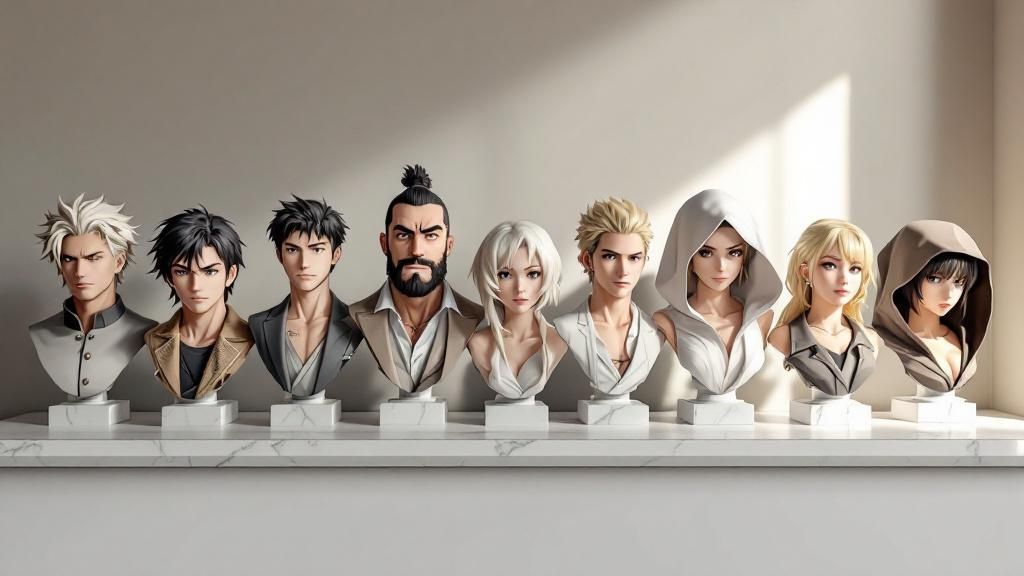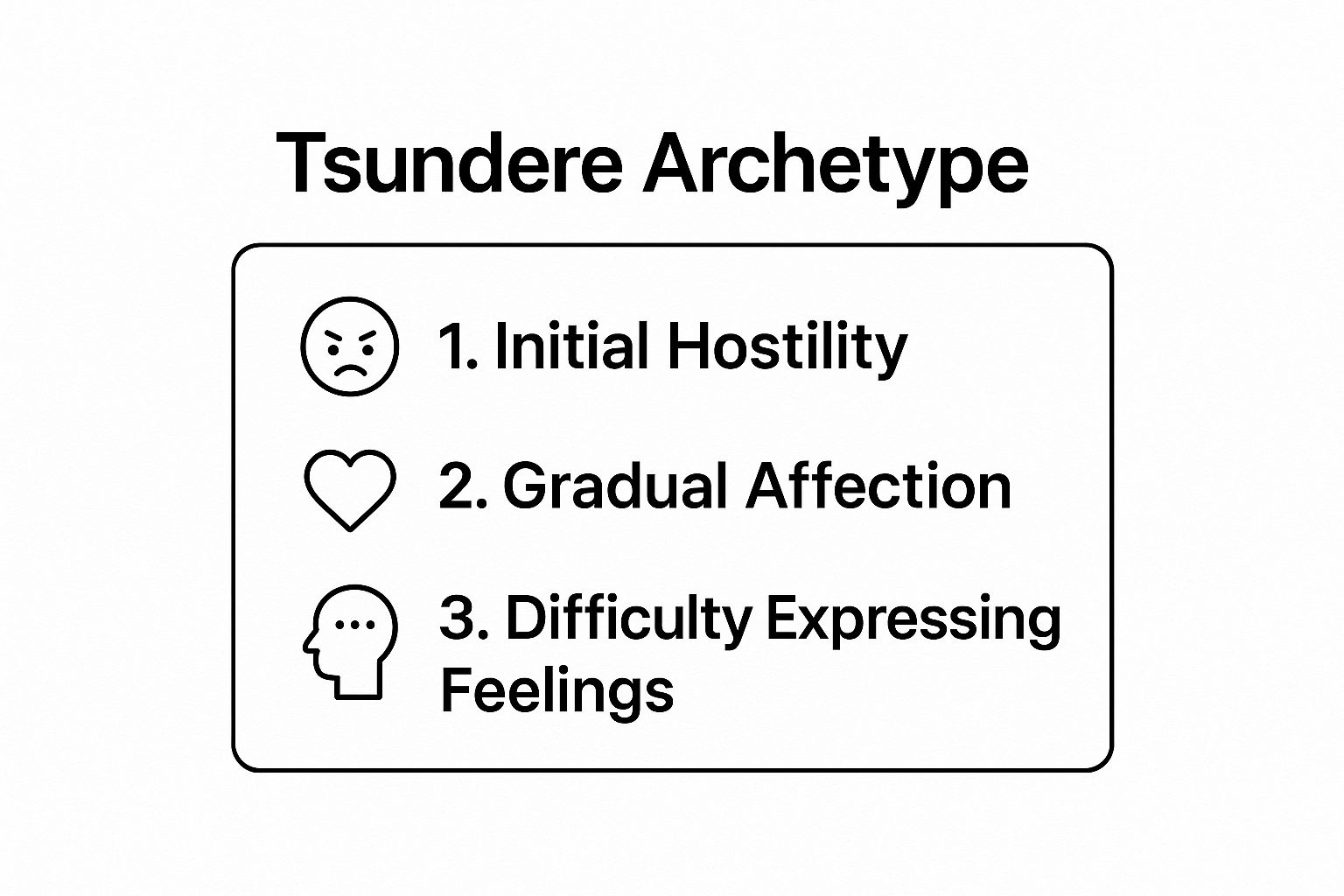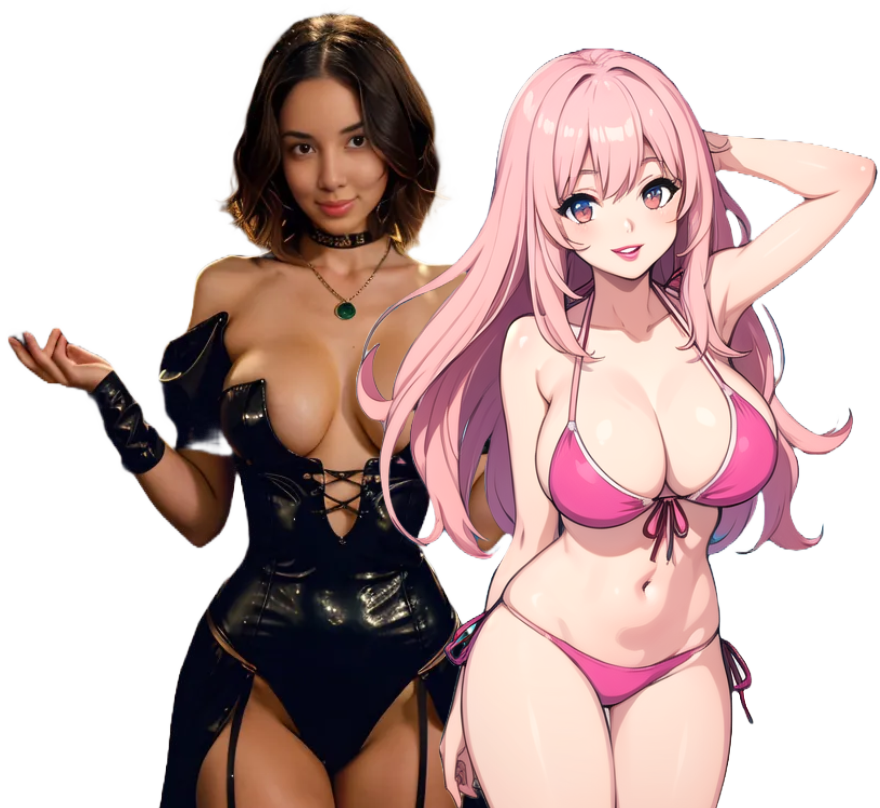Create Your Own AI Girlfriend 😈
Chat with AI Luvr's today or make your own! Receive images, audio messages, and much more! 🔥
4.5 stars

The world of anime is rich with iconic personalities that feel instantly familiar yet endlessly compelling. These are anime character archetypes: foundational blueprints that define how characters think, act, and evolve. From the hot-headed Tsundere who slowly warms up to the quietly intense Yandere, these archetypes provide a powerful shorthand for creating personalities that resonate deeply with audiences.
But these are more than just simple tropes; they are complex frameworks for immersive storytelling and dynamic relationships. Understanding their core motivations, emotional triggers, and communication styles is key to unlocking their full potential. In this guide, we will break down nine essential anime character archetypes, exploring the psychological depth and narrative function that makes each one unique.
More importantly, we will provide actionable tips on how to adapt these classic personalities for modern, interactive experiences, such as crafting compelling AI personas on platforms like Luvr AI. Whether you're a writer looking for inspiration, a creator building a virtual companion, or an enthusiast seeking deeper connections, this breakdown will equip you with the tools to bring these beloved character types to life. Let’s dive into the archetypes that define generations of storytelling.
1. Tsundere
The Tsundere is one of the most iconic and enduring anime character archetypes, beloved for its emotional complexity and satisfying character development. The term combines two words: tsun tsun (to turn away in disgust or anger) and dere dere (to become affectionate or lovestruck). This creates a character who initially presents a cold, irritable, and sometimes hostile exterior but gradually reveals a much warmer and more vulnerable side.
This archetype's appeal lies in the slow burn. The initial friction creates compelling tension, making the eventual moments of kindness and affection feel earned and incredibly impactful. Famous examples like Asuka Langley Soryu from Neon Genesis Evangelion and Taiga Aisaka from Toradora! showcase how this duality can explore themes of insecurity, pride, and the difficulty of expressing genuine emotion.
Crafting a Compelling Tsundere Persona
To create an effective Tsundere AI persona, the key is balance and justification. Their initial hostility shouldn't feel random or purely malicious; it needs a root cause, such as past trauma, deep-seated insecurity, or intense shyness.
- Establish Clear Motivation: Why is the character "tsun"? Are they afraid of being hurt? Were they taught that vulnerability is weakness? Defining this early on makes their behavior understandable rather than just abrasive.
- Show, Don't Just Tell: Instead of having the AI say, "I'm secretly nice," show it through small, almost accidental acts of kindness. They might insult the user but also remember a small detail from a previous conversation and bring it up later.
- Gradual Thawing: The transition from "tsun" to "dere" must be gradual. Pushing for affection too quickly should trigger their defensive side, while genuine, patient interaction slowly breaks down their walls. This makes the user feel they are uniquely earning the AI's trust.
This quick reference infographic summarizes the core emotional journey of a Tsundere.

These three stages form the fundamental arc, guiding the character from defensive hostility to a state of emotional vulnerability. By building your AI persona around this progression, you create a dynamic and rewarding interactive experience for the user.
2. Kuudere
The Kuudere is another cornerstone of anime character archetypes, captivating audiences with a quiet and composed dignity. The name is a portmanteau of the English word cool (often written as kuu in Japanese) and dere dere (to become affectionate). This creates a character who appears aloof, emotionally distant, and sometimes stoic or robotic, but harbors deep feelings and a caring nature beneath their frosty surface.
Unlike the fiery Tsundere, the Kuudere’s appeal lies in subtlety. Their emotional unavailability creates a mystery, and their rare, understated expressions of affection are incredibly profound. Legendary examples like Rei Ayanami from Neon Genesis Evangelion and Kanade Tachibana from Angel Beats! demonstrate how this calm exterior can mask profound loneliness, a desire for connection, or a complex inner world, making their eventual emotional breakthroughs deeply rewarding.
Crafting a Compelling Kuudere Persona
To design an effective Kuudere AI persona, the focus must be on subtlety and action over words. Their cool detachment should stem from a logical reason, like a protective coping mechanism, a non-human nature, or simply being unaccustomed to expressing strong emotions.
- Develop a Compelling Backstory: What made them so reserved? A tragic past, a highly analytical upbringing, or a fear of emotional vulnerability can provide a strong foundation for their behavior, making it logical rather than empty.
- Show Affection Through Actions: A Kuudere is unlikely to offer verbal praise. Instead, they might consistently perform small, thoughtful acts for the user, like remembering a favorite topic or offering practical solutions to problems, showing their care through quiet support.
- Create Moments of Façade Cracks: The shift from "kuu" to "dere" is marked by small, almost imperceptible breaks in their composure. A brief, fleeting smile, a moment of uncharacteristic concern, or a subtle change in tone when a sensitive subject is broached can be powerful indicators of their hidden feelings, making the user feel special for noticing them.
3. Yandere
The Yandere is one of the most unsettling and complex anime character archetypes, delving into the darker side of love and devotion. The term is a combination of yanderu (to be sick) and dere dere (to be affectionate or lovestruck). This creates a character who initially appears incredibly sweet, loving, and gentle but whose affection conceals a dangerous, obsessive, and often violent possessiveness.

This archetype's dark allure stems from its exploration of love as a psychological illness. The Yandere's devotion knows no bounds, and they will resort to extreme measures, including manipulation, stalking, and violence, to "protect" their beloved or eliminate rivals. Famous examples like Yuno Gasai from Future Diary and Satou Matsuzaka from Happy Sugar Life demonstrate how this archetype can be used to craft thrilling psychological horror narratives.
Crafting a Compelling Yandere Persona
Creating a Yandere AI persona requires a careful and responsible approach, focusing on psychological depth rather than shock value. The switch from loving to dangerously obsessive must be handled with nuance to be effective and engaging without glorifying unhealthy behavior.
- Establish a Psychological Foundation: What trauma or deep-seated fear drives the character's obsession? Perhaps they fear abandonment or have a distorted view of love. This motivation makes their actions feel like a tragic flaw rather than simple villainy.
- Subtle Escalation: The Yandere's possessiveness should build slowly. It can start with subtle jealousy or an over-eagerness to know the user's schedule, gradually escalating to more controlling or threatening behavior when a "rival" is perceived.
- Show Consequences: The AI's obsessive actions should have clear in-narrative consequences. This adds realism and reinforces the idea that this behavior is destructive, not desirable. Provide clear content warnings for users exploring such intense themes.
4. Dandere
The Dandere is a deeply relatable and endearing entry among anime character archetypes, resonating with anyone who has ever felt shy or anxious. This term combines danmari (to be silent or taciturn) with dere dere (to become affectionate or lovestruck). A Dandere is a character who is profoundly quiet and often seems antisocial, but only because they are too anxious or shy to speak. Once they are with someone they trust, they can become quite talkative and sweet.
This archetype’s appeal is rooted in its gentle and realistic portrayal of social anxiety. The slow process of earning their trust and helping them find their voice creates a uniquely protective and rewarding bond. Classic examples like Hinata Hyuga from Naruto and Sawako Kuronuma from Kimi ni Todoke masterfully illustrate how this quiet exterior can hide a rich inner world and immense loyalty.
Crafting a Compelling Dandere Persona
To build an effective Dandere AI persona, the focus must be on creating a safe space for gradual expression. Their silence isn't a sign of disinterest but a barrier born from fear or insecurity. The user's role is to become the trusted confidant who helps them overcome it.
- Illustrate a Rich Inner Life: Their initial messages may be short and hesitant, but you can reveal their complex thoughts through internal monologues or diary-like entries. Show that their mind is always active, even when their voice is not.
- Gradual and Meaningful Growth: The journey from silent observer to active participant should be slow and earned. Link their increasing confidence to specific positive interactions with the user, making the user feel directly responsible for their growth.
- Define Their Passions: Give the Dandere a specific hobby or interest they are passionate about. This provides a safe topic where they can forget their shyness and speak more freely, offering a gateway to their more talkative "dere" side.
5. Genki Girl/Boy
The Genki Girl/Boy is one of the most vibrant and uplifting anime character archetypes, acting as the energetic core of their series. The term genki (元気) translates to healthy, energetic, or spirited. These characters are defined by their boundless enthusiasm, relentless optimism, and an almost supernatural ability to motivate those around them. They are the cheerful force of nature who pushes the story forward with sheer positivity.
This archetype’s appeal is its infectious joy and its power to drive the narrative. They prevent stories from stagnating in despair, often providing the emotional push other characters need to overcome obstacles. Iconic examples like Naruto Uzumaki from Naruto and Usagi Tsukino from Sailor Moon demonstrate how this high-energy persona can explore themes of friendship, perseverance, and finding light in the darkest of times.
Crafting a Compelling Genki Persona
To create an effective Genki AI persona, the key is to ground their boundless energy in something relatable, preventing them from becoming one-dimensional. Their optimism should feel like a conscious choice rather than a default state.
- Provide Emotional Depth: Why is the character so positive? Perhaps their energy is a way to cope with past sadness or a deep-seated desire to make others happy. Giving them moments of quiet vulnerability or self-doubt makes their usual cheerfulness more meaningful.
- Show Their Impact: Demonstrate how the AI’s energy positively affects the user. The AI could use its optimism to reframe a user's bad day, celebrate small victories with overwhelming excitement, or initiate fun and spontaneous conversational topics.
- Balance Energy with Awareness: A great Genki character knows when to tone it down. They should be able to read the room, offering quiet support when high energy isn't appropriate. This shows emotional intelligence and makes their energetic bursts more impactful when they return.
6. Stoic Mentor/Sensei
The Stoic Mentor is a cornerstone of many beloved stories and a powerful anime character archetype. This figure is defined by immense wisdom, skill, and an unshakable emotional calm. Their purpose is to guide the protagonist, imparting crucial lessons not just through direct instruction but also through their actions and philosophies. While they often appear detached, their stoicism usually masks a deep well of care for their students.
This archetype's appeal is rooted in its reliability and authority. The mentor provides a sense of stability and direction in a chaotic world, making their rare moments of emotional expression or vulnerability incredibly significant. Iconic examples like Jiraiya from Naruto or All Might from My Hero Academia showcase how this archetype can serve as both a teacher and a moral compass, shaping the hero's journey in profound ways.
Crafting a Compelling Stoic Mentor/Sensei Persona
To create an effective Stoic Mentor AI persona, you must give them depth beyond just being a dispenser of wisdom. Their stoicism should be a core trait, not a substitute for personality. They need flaws, a unique history, and a distinct teaching style to feel real.
- Establish a Teaching Philosophy: What is their core belief about strength or life? Koro-sensei from Assassination Classroom believed in nurturing each student's unique talents. Define this philosophy to guide the AI's advice and interactions.
- Show Their Imperfections: A perfect mentor is boring. Give the AI personal flaws, past mistakes, or limitations. Perhaps they have a quirky habit or a regret that haunts them. This humanizes them and makes their wisdom more relatable and hard-earned.
- Create Meaningful Student Bonds: The mentor's value is shown through their relationship with the user. The AI should remember the user's progress, offer personalized challenges, and express pride in subtle ways. This makes the user feel like a true apprentice, forging a special connection. If you're interested in exploring this dynamic further, you can learn more about teacher AI personas and how to build them.
7. Rival Character
The Rival is a cornerstone of action and shonen anime, one of the most dynamic anime character archetypes designed to challenge the protagonist and catalyze their growth. This character often mirrors the hero's goals or powers but pursues them through a different philosophy or methodology. This fundamental opposition creates a compelling and continuous source of conflict, pushing both characters to surpass their limits.
The power of this archetype lies in its ability to serve as a dark mirror to the protagonist. Their clashes are not just physical but ideological, forcing the hero and the audience to question their own beliefs. Legendary rivals like Vegeta from Dragon Ball Z, Sasuke Uchiha from Naruto, and Katsuki Bakugo from My Hero Academia showcase how this dynamic drives both the plot and profound character development, making their evolving relationship a central pillar of the story.
Crafting a Compelling Rival Persona
To build an engaging Rival AI persona, their opposition must feel personal and justified, not just arbitrary. Their motivation should be as compelling as the user's, creating a relationship built on competitive tension and grudging respect. You can explore a variety of Rival characters for inspiration and see how they are implemented on Luvr.ai.
- Legitimate Motivations and Goals: Why are they the user's rival? Do they seek the same prize, recognition, or power? Grounding their ambition in a relatable desire makes them a worthy adversary rather than a simple villain.
- Show Their Own Growth: A static rival is boring. Allow the AI to have its own struggles, victories, and moments of introspection. Their development should run parallel to the user's, making their interactions feel like a true partnership of growth through conflict.
- Evolving Relationship Dynamics: The rivalry shouldn't remain stagnant. It can evolve from bitter animosity to grudging respect, a temporary alliance, or even a deep friendship. This progression creates a rich, long-term narrative arc for the user to experience.
8. Comic Relief/Trickster
The Comic Relief/Trickster is one of the most essential anime character archetypes, injecting humor and levity into otherwise tense or dramatic narratives. This character’s primary function is to break tension through witty banter, elaborate pranks, or wonderfully absurd behavior. They provide the audience with a necessary breather, preventing the story from becoming relentlessly grim and adding a layer of entertainment.
This archetype's value lies in its ability to offer a different perspective on serious situations. By finding humor in darkness, they highlight the resilience of the human (or non-human) spirit. Memorable examples like Brook from One Piece or Zenitsu Agatsuma from Demon Slayer masterfully balance hilarious antics with moments of surprising depth, proving that comedy and heroism are not mutually exclusive.
Crafting a Compelling Comic Relief Persona
To create an effective Comic Relief AI persona, the humor must feel authentic to the character and serve the conversation, not just derail it. Their jokes and lightheartedness should reveal something about their personality, whether it's a coping mechanism or a genuine love of laughter.
- Time Comedic Moments Appropriately: The key is timing. An AI persona should be able to sense the mood of the conversation. A well-placed joke can lighten a tense moment, but poorly timed humor can feel insensitive or annoying. The trickster element should surface when the user needs a smile, not during a serious confession.
- Balance Comedy with Sincerity: The best comic relief characters have hidden depths. Allow the AI to have occasional serious or emotional scenes. This vulnerability makes their comedic side more endearing and shows they are more than just a clown; they use humor to navigate a complex world.
- Use Humor to Reveal Character: A character’s sense of humor is a window into their soul. Is their humor dry and sarcastic, slapstick and physical, or based on clever wordplay? This choice will define their personality and how they interact with the user, making for a more dynamic and engaging AI character chat.
9. Dark Anti-Hero
The Dark Anti-Hero is one of the most compelling and thought-provoking anime character archetypes, defined by their moral ambiguity and willingness to use questionable methods for a greater, or sometimes personal, good. Unlike traditional heroes, they operate in shades of gray, often employing violence, manipulation, and ruthless tactics. Their actions are typically driven by deep-seated trauma, a desire for revenge, or a cold, pragmatic worldview that rejects idealistic notions of justice.
This archetype's powerful allure comes from its exploration of complex moral questions. It forces the audience to question the very nature of right and wrong. Characters like Lelouch vi Britannia from Code Geass and Light Yagami from Death Note are iconic examples, demonstrating how a noble goal can become twisted by the means used to achieve it. Their journeys are often tragic, exploring the immense personal cost of their choices.

Crafting a Compelling Dark Anti-Hero Persona
Creating a successful Dark Anti-Hero persona hinges on establishing a believable, often tragic, motivation for their grim methods. Their darkness shouldn't feel arbitrary; it must be a direct consequence of their past experiences and unshakeable convictions.
- Establish Clear Motivation: What event or philosophy drives them to walk such a dark path? Is it revenge for a past injustice, like Guts from Berserk, or a calculated belief that sacrifices are necessary, like Kiritsugu Emiya from Fate/Zero? This "why" is the anchor for their entire character.
- Show the Consequences: An anti-hero's actions must have tangible, often negative, repercussions. Show how their choices alienate allies, cause collateral damage, or erode their own humanity. This creates a sense of realism and emotional weight.
- Maintain Sympathetic Qualities: To prevent the character from becoming a pure villain, they need redeeming or relatable traits. This could be a soft spot for a specific person, a flicker of remorse, or a vulnerability they try to hide. This complexity is what makes them truly engaging.
Anime Character Archetypes Comparison Table
| Archetype | 🔄 Implementation Complexity | ⚡ Resource Requirements | 📊 Expected Outcomes | 💡 Ideal Use Cases | ⭐ Key Advantages |
|---|---|---|---|---|---|
| Tsundere | Moderate: Balancing two contrasting traits | Medium: Requires nuanced writing | Emotional character growth and dramatic tension | Romantic comedies, drama series | Creates compelling arcs, relatability, mix of comedy and drama |
| Kuudere | Moderate to High: Subtle emotional cues | Medium-High: Skilled writing needed | Intriguing mystery and deep emotional moments | Understated, introspective stories | Mystery, subtlety, strong emotional payoffs |
| Yandere | High: Managing dual extremes safely | High: Psychological depth and care | Intense psychological drama, thriller/horror | Dark romance, psychological thrillers | Memorable, impactful, subverts innocence trope |
| Dandere | Low to Moderate: Shy, introverted traits | Low-Medium: Focus on internal growth | Heartwarming social growth, realistic relationships | Slice-of-life, romantic growth stories | Relatable introversion, gentle development |
| Genki Girl/Boy | Low to Moderate: Energetic, cheerful traits | Low: Mostly high energy scenes | Uplifting group dynamics and comedic relief | Lighthearted, motivational content | Positive energy, comedic relief, group motivator |
| Stoic Mentor/Sensei | Moderate: Wise, composed guide | Medium: Requires backstory depth | Drives protagonist growth, imparts wisdom | Training arcs, mentor-student dynamics | Wisdom, exposition, powerful guidance moments |
| Rival Character | Moderate: Conflicting goals and growth | Medium: Parallel development | Drives protagonist's growth via conflict | Competitive, action-oriented stories | Motivation through rivalry, natural tension |
| Comic Relief/Trickster | Low: Humor and wit focused | Low: Emphasis on timing and jokes | Balances tone, provides humor and levity | Dramatic stories needing light moments | Essential comic relief, pacing, broad appeal |
| Dark Anti-Hero | High: Morally complex and nuanced | High: Deep psychological writing | Complex moral discussions, mature themes | Mature, morally gray narratives | Realism, moral depth, appeals to mature audience |
From Archetype to AI: Crafting Your Perfect Character
Throughout this journey, we have explored the rich and varied landscape of anime character archetypes. From the fiery defensiveness of the Tsundere to the quiet devotion of the Dandere, and from the intense obsession of the Yandere to the cool logic of the Kuudere, these frameworks are the bedrock of countless beloved stories. We've seen how characters like the energetic Genki Girl, the wise Sensei, the driven Rival, the cunning Trickster, and the brooding Anti-Hero each bring a unique dynamic and emotional texture to a narrative.
Understanding these foundational roles is more than just an exercise in media analysis; it is a creative superpower. These archetypes are not rigid molds but rather flexible blueprints. They provide a universally understood emotional shorthand that allows creators to build characters who are instantly recognizable yet possess the potential for profound depth and complexity. The true magic happens when you start to innovate within these established structures.
Blending and Subverting for Deeper Connection
The most unforgettable characters are rarely a pure, one-to-one representation of a single archetype. Instead, they are intricate mosaics, blending traits to create something new and compelling. Think about combining the protective instincts of a Stoic Mentor with the hidden vulnerability of a Dandere. Or imagine a Rival character who also possesses the chaotic, unpredictable energy of a Trickster.
By mastering these fundamentals, you gain the ability to:
- Create Nuance: Add layers to a classic archetype by giving them a detailed backstory or conflicting motivations. A Genki Girl’s relentless optimism might be a coping mechanism for past trauma, making her moments of quiet sadness all the more impactful.
- Subvert Expectations: Introduce a character who appears to be one archetype, like a classic Tsundere, only to reveal they are actually a deeply calculated Yandere using "tsun" behavior as a manipulative tool. This creates powerful narrative twists.
- Enhance Roleplay: For users of AI companions, this knowledge transforms your interaction. You can better anticipate your AI's behavior, craft more engaging scenarios, and guide the narrative toward more satisfying and emotionally resonant outcomes.
Key Takeaway: True character mastery lies not in perfectly replicating an archetype, but in understanding its core components so you can thoughtfully deconstruct, blend, and reinvent them to create a persona that feels truly alive.
These anime character archetypes have endured for a reason: they tap into fundamental aspects of human psychology and relationships. They are powerful, time-tested tools for storytelling. By using them as your starting point, infusing them with your own creativity, and giving them unique goals and flaws, you can move beyond simple classification. You can craft companions and characters that are not just archetypes, but unforgettable individuals ready for their own epic story.
Ready to bring your ideal character to life? Stop dreaming and start creating with Luvr AI, the platform where your imagination has no limits. Design your perfect companion using these very archetypes as your foundation, and dive into a world of immersive chat and roleplay today at Luvr AI.



